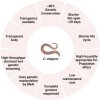Recent advances and current challenges of new approach methodologies in developmental and adult neurotoxicity testing
- PMID: 38480536
- PMCID: PMC10965660
- DOI: 10.1007/s00204-024-03703-8
Recent advances and current challenges of new approach methodologies in developmental and adult neurotoxicity testing
Abstract
Adult neurotoxicity (ANT) and developmental neurotoxicity (DNT) assessments aim to understand the adverse effects and underlying mechanisms of toxicants on the human nervous system. In recent years, there has been an increasing focus on the so-called new approach methodologies (NAMs). The Organization for Economic Co-operation and Development (OECD), together with European and American regulatory agencies, promote the use of validated alternative test systems, but to date, guidelines for regulatory DNT and ANT assessment rely primarily on classical animal testing. Alternative methods include both non-animal approaches and test systems on non-vertebrates (e.g., nematodes) or non-mammals (e.g., fish). Therefore, this review summarizes the recent advances of NAMs focusing on ANT and DNT and highlights the potential and current critical issues for the full implementation of these methods in the future. The status of the DNT in vitro battery (DNT IVB) is also reviewed as a first step of NAMs for the assessment of neurotoxicity in the regulatory context. Critical issues such as (i) the need for test batteries and method integration (from in silico and in vitro to in vivo alternatives, e.g., zebrafish, C. elegans) requiring interdisciplinarity to manage complexity, (ii) interlaboratory transferability, and (iii) the urgent need for method validation are discussed.
Keywords: Adult neurotoxicity; Adverse outcome pathways; Developmental neurotoxicity; New approach methodologies.
© 2024. The Author(s).
Conflict of interest statement
The authors declare that they have no conflict of interest.
Figures



Similar articles
-
Developmental neurotoxicity (DNT): A call for implementation of new approach methodologies for regulatory purposes: Summary of the 5th International Conference on DNT Testing.ALTEX. 2025;42(2):323-349. doi: 10.14573/altex.2503191. ALTEX. 2025. PMID: 40235170
-
Mapping out strategies to further develop human-relevant, new approach methodology (NAM)-based developmental neurotoxicity (DNT) testing.ALTEX. 2025;42(2):308-322. doi: 10.14573/altex.2501091. Epub 2025 Jan 14. ALTEX. 2025. PMID: 39826153
-
Zebrafish and nematodes as whole organism models to measure developmental neurotoxicity.Crit Rev Toxicol. 2024 May;54(5):330-343. doi: 10.1080/10408444.2024.2342448. Epub 2024 Jun 4. Crit Rev Toxicol. 2024. PMID: 38832580 Review.
-
A perspective on In vitro developmental neurotoxicity test assay results: An expert panel review.Regul Toxicol Pharmacol. 2023 Sep;143:105444. doi: 10.1016/j.yrtph.2023.105444. Epub 2023 Jul 11. Regul Toxicol Pharmacol. 2023. PMID: 37442267 Review.
-
How neurobehavior and brain development in alternative whole-organism models can contribute to prediction of developmental neurotoxicity.Neurotoxicology. 2024 May;102:48-57. doi: 10.1016/j.neuro.2024.03.005. Epub 2024 Mar 28. Neurotoxicology. 2024. PMID: 38552718 Free PMC article. Review.
Cited by
-
Machine learning-based analysis of microfluidic device immobilized C. elegans for automated developmental toxicity testing.Sci Rep. 2025 Jan 2;15(1):15. doi: 10.1038/s41598-024-84842-x. Sci Rep. 2025. PMID: 39747450 Free PMC article.
-
Bridging imaging-based in vitro methods from biomedical research to regulatory toxicology.Arch Toxicol. 2025 Apr;99(4):1271-1285. doi: 10.1007/s00204-024-03922-z. Epub 2025 Feb 13. Arch Toxicol. 2025. PMID: 39945818 Free PMC article. Review.
-
Optimal Production of 3D Neuronal Lineage Population by Morphological Classification.Tissue Eng Regen Med. 2025 Jul;22(5):661-674. doi: 10.1007/s13770-025-00721-0. Epub 2025 May 13. Tissue Eng Regen Med. 2025. PMID: 40358835
-
Regulatory trends of organophosphate and pyrethroid pesticides in cannabis and applications of the Comparative Toxicogenomics Database and Caenorhabditis elegans.Toxicol Sci. 2025 Apr 1;204(2):218-227. doi: 10.1093/toxsci/kfaf009. Toxicol Sci. 2025. PMID: 39836634 Free PMC article.
References
-
- Abud EM, Ramirez RN, Martinez ES, Healy LM, Nguyen CHH, Newman SA, Yeromin AV, Scarfone VM, Marsh SE, Fimbres C, Caraway CA, Fote GM, Madany AM, Agrawal A, Kayed R, Gylys KH, Cahalan MD, Cummings BJ, Antel JP, Mortazavi A, Carson MJ, Poon WW, Blurton-Jones M. iPSC-Derived Human Microglia-like Cells to Study Neurological Diseases. Neuron. 2017 doi: 10.1016/j.neuron.2017.03.042. - DOI - PMC - PubMed
-
- Alimohammadi M, Meyburg B, Ückert AK, Holzer AK, Leist M (2023) EFSA Pilot Project on New Approach Methodologies (NAMs) for Tebufenpyrad Risk Assessment. Part 2. Hazard characterization and identification of the Reference Point. EFSA support Publ. EN-7794. 56 pp. 10.2903/sp.efsa.2023.EN-7794
-
- American Psychiatric Association (2013) Diagnostic and Statistical Manual of Mental Disorders, Fifth Edition. Arlington, VA, American Psychiatric Association

